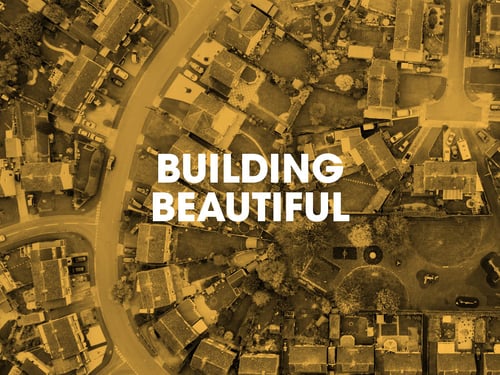What is the Building Better, Building Beautiful Commission?
The purpose of the Building Better, Building Beautiful Commission is to tackle the challenge of designing and building homes and places that “help to grow a sense of community and place.” It is gathering evidence from public and private sectors to “develop practical policy solutions” for new developments, new towns and villages, and the UK’s high streets.
The Commission will produce a final report by the end of 2019, intended to inform the work of the Ministry of Housing, Communities and Local Government.
Early proposals from the interim report
The report advocates developing “beautiful” places, but what does this mean? Beauty is not just what homes or buildings look like, but encompasses the wider “spirit of the place”, overall settlement patterns and their interaction with nature. It describes beauty in three levels:
- Beautiful buildings – considering windows, height, space and materials
- Beautiful places – the “spirit of the place”, the nature of streets, squares and parks, for example
- Beautifully placed – sustainable settlement patterns in the right place and sitting in the landscape.
Priorities for reform
The report describes eight priorities to help develop beautiful places, which includes a whole raft of proposals including changes to the planning system, legal frameworks and tax regimes.
- Beauty first. Beauty, place-making and sustainable development should be embedded in the National Planning Policy Framework and included in Local Plans
- Places, not just houses. The report describes creating “walkable mixed-use places for all our daily needs,” requiring potential changes to legal and tax regimes to better support a “long-term stewardship model of land and infrastructure investment,” replacing the current side-by-side arrangements
- Regenerative developments. The focus here is more on retail and the high street, proposing a “rebalancing” of the business rates system and moving away from large-format supermarkets to mixed developments including homes, retail and commercial
- Early collaboration, not confrontation. The report argues for wider community engagement through plan making and development control, making better use of digital technologies to achieve this
- A level playing field. There is an “urgent need to reduce planning risk” to smaller firms, community land trusts and self- and custom-build operators through a “more predictable” planning framework, design policy and standards
- Growing beautifully. The commission wants to explore how councils can better collaborate with local enterprise and nature partnerships to create mixed-use and “gentle density” settlements with vibrant centres. The report singles out tackling “car dominance” when designing places
- Learning together. Planners, officials, highways engineers and local councillors need greater understanding of place-making, architecture, design and connections between urban form and design and people’s wellbeing and health
- Making beauty count. The report simultaneously recognises that planning needs to be resourced and charged to enable better quality, certainty, consistency and efficiency, to encourage early engagement, while at the same time better use digital technology to speed up the process. “We also need to measure what really matters,” the report adds, reiterating outcomes such as wellbeing, health and “nature recovery.”
What to expect next
The Commission will continue to collect evidence and test their interim proposals in more detail through the rest of 2019. You can view the interim report here, via the Government website. A final report is due to be published by the end of the year (2019). Further comments and evidence can be submitted to the commissioners by email: BBBBCommission@communities.gov.uk
- The report references a number of policy areas designed to make new homes and buildings more energy efficient.


Have your say